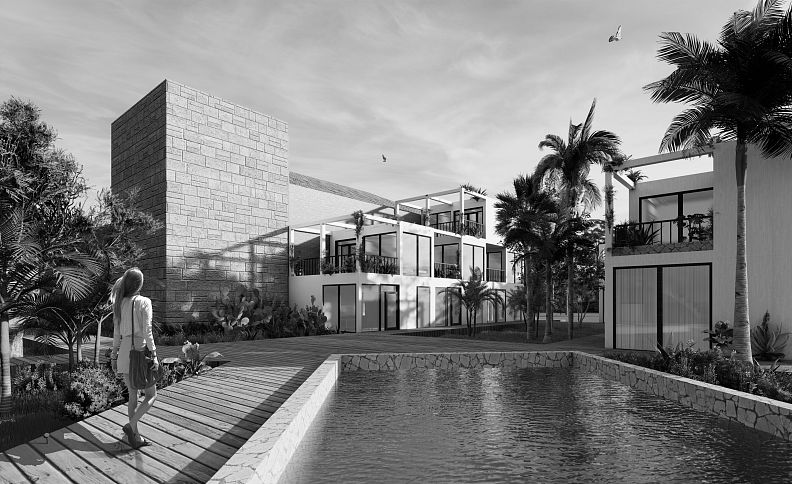Prefab Housing

Project idea
The design goal was to create a space for people who want to escape from overcrowded and noisy city centers and regenerate. It is an ideal place for someone with various mental health problems, and it can also be a form of relaxation and detachment for a while. The aim was also to preserve and emphasize the authenticity of the history of the place, so that the designed objects were very simple and did not fight the most important tower on the plot. Another important aspect is designing with respect to the natural environment. For this purpose, organic materials (e.g. wood) were used to finish the facade, and all existing trees on the plot were preserved.
Project description
The designed architectural complex is located in Spain, north of the city of Alicante on the east-south coast. Currently, there is a building complex on the plot, consisting of several interconnected buildings. The most important element in its area is the tower from the 16th century - Torre de Salafranca. Built on a square plan, the walls are 10 meters high and 1 meter thick. The structure was part of a tower system that provided surveillance and protection for the inhabitants when Campo de Alicante was attacked by Berber pirates. An important element is the pond next to the structure. Its renovation is also planned.
The designed objects are prefabricated modules. They have a simple form, based on a regular square grid, one section of which corresponds to the width of the tower. The modular mesh is based on division; 6 meters, 3 meters and 1 meter. The module is a cube with dimensions of 3m x 3m x 3m, by combining them, you can get 7 versions of apartments - in order to adapt them to the needs of guests. The investment construction process is divided into 3 stages. In the first one, it is planned to build three apartments - for the disabled, singles and couples. In the next stage, modules for friends and more for singles will be added, and in the final stage there will be an apartment for a family and a second apartment for couples. The area under development has been divided into utility zones; integration, recreational, green, entrance and communications, and a separate part has been made private and part intended for guests.
Technical information
Thanks to the favorable climate and plenty of sunshine, solar energy was used to provide energy in the facilities. Based on the calculated annual electricity consumption in each apartment, photovoltaic panels covering the energy demand in buildings were calculated and designed. The process of building modules in the workshop and their transport to the construction site were also analyzed. There is also a schedule of activities with an indication of their duration and location. A skeleton structure was used using steel profiles, and further material solutions were also provided for in each partition.
Documentation
Show PDF 1Show PDF 2Show PDF 3Show PDF 4Show PDF 5Show PDF 6Show PDF 7Show PDF 8Show PDF 9Show PDF 10Show PDF 11Show PDF 12Show PDF 13Show PDF 14Show PDF 15Show PDF 16Show PDF 17Show PDF 18Show PDF 19Show PDF 20Show PDF 21Show PDF 22Show PDF 23Show PDF 24Show PDF 25Show PDF 26Show PDF 27Show PDF 28Show PDF 29Show PDF 30
































